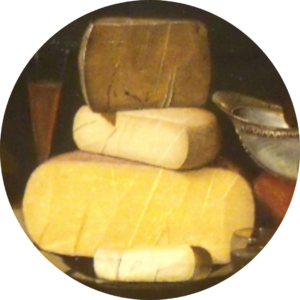The Wine for cheese
Your wine is an Italian Soave
| Body | Light to medium bodied – moderate acidity, low alcohol |
| Grape flavours | Green apple, pear, lemon, and sometimes hints of apricot or peach. Herbaceous (marjoram, oregano), a subtle almond or nutty undertone. |
| Winemaker flavours | Some smoothness of texture from lees aging, with light creaminess and possible hint of biscuit |
| Aged flavours | Generally none. Older wines may offer honey, dried fruits and minerality |
More about the Wine
Soave is a white wine not a grape, named for the town of Soave in north eastern Italy. Its origins can be traced to the 1st century BC, when the Romans first cultivated vineyards in the Veneto region, north of modern Venice, using the not easy to remember Garganega grape.
Monastic orders and local winemakers refined their grape-growing and winemaking techniques, leading to improved wine quality. Soave became a symbol of wealth and prestige in the medieval courts of Verona and Venice.
In the 14th century, the Serenissima Republic of Venice recognized the value of the Soave vineyards and their unique terroir, and laws were passed to protect the quality and reputation of Soave wine. During this period, the characteristic volcanic hillside vineyards of Soave Classico were established.
In 1931, Soave received official recognition as a Denominazione di Origine Controllata (DOC), one of Italy’s first. This designation laid the groundwork for quality standards and regulations that would protect and define Soave wine production. In 2001, Soave earned the prestigious Denominazione di Origine Controllata e Garantita (DOCG) status, the highest level of Italian wine classification, for the Soave Superiore DOCG.
Today, Soave wine producers are committed to sustainable and organic vinicultural practices, focusing on preserving the unique terroir of the region. The Garganega grape remains the dominant variety in Soave wines but is little grown elsewhere in the world, making Soave a small but outstanding wine style.
Soave wine’s versatility makes it suitable for a wide range of occasions, from casual sipping to fine dining. It pairs beautifully with a variety of Italian dishes, including seafood, risotto, and pasta. Its refreshing acidity and balanced profile make it an ideal choice for warm-weather enjoyment.
Tasting Notes for Soave Wine:
Body: typically has a light to medium body, elegant and refreshing. It has a crisp acidity giving it a zesty quality. Typically dry wine, with little to no perceptible sweetness. It is appreciated for its clean and crisp finish.
Grape Flavors:
- Garganega: imparts ripe green apple, white peach, and citrus. In warmer climes you can get melon, even tangerine. Herb notes of marjoram are sometimes present
- Trebbiano di Soave: Used in some traditional Soave blends, Trebbiano may add light citrus, green apple, white peach with floral notes, making the wine more aromatic
Flavouring: Inn general Soave wines are not flavoured by oak. They may have limited lees aging or malolactic conversion, giving them a less forward acidity and some smoothness, with potential for toasted almond or creamy notes.
Aging: Up to three years is typical, so no notable aging notes. Some rarer examples age up to seven years, giving flavours towards honey, dried fruits, and sometimes a touch of minerality
There is broad range in quality from light (even bland) to iconic.


